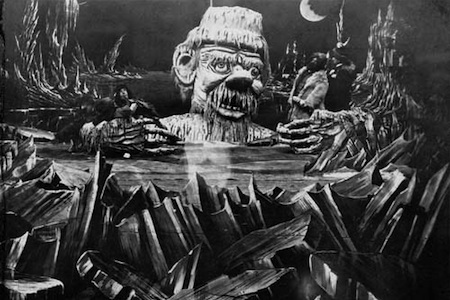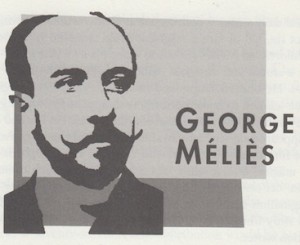Born: December 8, 1861, Paris, France
Died: January 21, 1938, Paris, France
I owe him everything.
—D.W. Griffith
The life of Georges Méliès is the stuff of great fiction. As a child, Méliès found an escape from his family’s machinery business by skipping off to a Paris theater in the afternoons, where he was captivated by the optical illusions of magician Robert Houdin. By the age of thirty-four, Méliès would own the Houdin Theatre, and he himself would perform startling illusions there. As an amateur magician, he explored new ideas to keep his youthful patrons coming back for more.
The Film 100
1. W.K. Laurie Dickson
2 Edwin S. Porter
3. Charlie Chaplin
4. Mary Pickford
5. Orson Welles
6. Alfred Hitchcock
7. Walt Disney
8. D.W. Griffith
9. Will Hays
10 Thomas Edison
11. John Wayne
12. J.R. Bray
13. Billy Bitzer
14. Jesse Lasky
15. George Eastman
16. Sergei Eisenstein
17. André Bazin
18. Irving Thalberg
19. Thomas Ince
20. Marlon Brando
21. Louis B. Mayer
22. Greta Garbo
23. Robert Flaherty
24. Lon Chaney
25. Anita Loos
26. George Méliès
27. Adolph Zukor
28. John Gilbert
29. Max Fleischer
30. John Ford
31. William Fox
32. George Lucas
33. Linwood Gale Dunn
34. Eadweard Muybridge
35. Katharine Hepburn
36. Winsor McCay
37. Stanley Kubrick
38. Buster Keaton
39. James Agee
40. Fritz Lang
41. Marcus Loew
42. Cedric Gibbons
43. James Cagney
44. Ben Hecht
45. Ingmar Bergman
46. Humphrey Bogart
47. Leon Schlesinger
48. Louella Parsons
49. Roger Corman
50. Edith Head
51. Bernard Herrmann
52. Gary Cooper
53. Mike Todd
54. Ernst Lubitsch
55. Sidney Poitier
56. Saul Bass
57. Billy Wilder
58. Bette Davis
59. Erich von Stroheim
60. Max Factor
61. Auguste and Louis Lumière
62. Woody Allen
63. Clark Gable
64. David O. Selznick
65. Gregg Toland
66. Lillian Gish
67. William Cameron Menzies
68. Lucille Ball
69. Samuel Rothafel
70. Akira Kurosawa
71. Marilyn Monroe
72. Vittorio De Sica
73. Natalie Kalmus
74. Gene Siskel and Roger Ebert
75. Willis O’Brien
76. Shirley Temple
77. Yakima Canutt
78. Sam Peckinpah
79. Jackie Coogan
80. Federico Fellini
81. Leni Riefenstahl
82. Steven Spielberg
83. Sam Warner
84. Jean-Luc Godard
85. Robert De Niro
86. Fred Astaire
87. Francis Ford Coppola
88. Ted Turner
89. Clint Eastwood
90. Dalton Trumbo
91. Dennis Hopper
92. Richard Hollingshead
93. Melvin Van Peebles
94. John Chambers
95. Mack Sennett
96. Martin Scorsese
97. Karl Struss
98. Busby Berkeley
99. John Hubley
100. John Cassavetes
In 1895, Méliès went to see a demonstration of the Lumière brothers’ Cinématographe in Paris, the first public display of motion pictures. In the audience that day was another future film pioneer, Alice Guy Blaché. The two were both amazed and inspired by the possibilities of moving images. Each would conceive of a new direction: Blaché would become the first to capture a narrative on film, while Méliès went on to become the most influential celluloid storyteller of his day.
After unsuccessful attempts to purchase a system from the Lumières, Méliès rushed home to build his own camera-projector. He presented a selection of film shorts made at the Edison studio in conjunction with a live program of magic at his Houdin Theatre just four months later. However, the Edison features, like the Lumière previews, were sixty-second recordings of typical daily scenes—such scenes as factory workers leaving for home. This was not the bill of fare a magician could combine with live theater to entertain children, so Méliès set out to make his own films.
He built a studio and designed elaborate sets and costumes for his fantastic stories. He crafted scripts and recruited pretty French girls. By trial and error, he learned to make performers disappear by stopping his camera in midshot, removing the actors and continuing on. He learned of the wonders that appeared on the screen after he wound the negatives back and exposed the film twice. He played with different shutter speeds and discovered more magical effects while experimenting with such camera tricks as slow motion, dissolves, fade-outs and superimposition. Better yet, Méliès let his imagination dictate the best applications of theses newfound techniques; his story films showed the touch of both a curious inventor and a science fiction writer.
Most of the early Méliès stories began as staged magic shows. As the master of ceremonies, Méliès often dressed as a conjurer who could sever the limbs of victims through special effects. His output at this time was astounding; he worked at a rapid pace, following his own muse when creating original stories or adapting classic literary works as in his mini-epics Cleopatra (1899) and Hamlet (1908). His hurried pace, however, often resulted in shoddy craftsmanship. He hand-painted colors onto many of his films and placed awkward sliding cards between frames to signal transitions. But what Méliès’s entries lacked in theme and execution, they made up for in energy and imagination. His films were highly successful and show his knack for sheer entertainment.
At one time Méliès was the world’s most prolific producer, and his films were widely successful in the United States and imitated all over the world. Other directors surpassed him quickly with new narrative devices, but Méliès commanded the lion’s share of the market with a steady supply of entertaining shorts. He made over five hundred films in all, financing, directing, photographing and acting in nearly every one. Most of these films were less than ten minutes long, and a great majority of them have since been lost. Both Porter and Griffith expressed their admiration of Méliès and cited his films as a major influence on much of their early work.
By 1900, illegal duplication of Méliès’s films was so common that the filmmaker was forced to put a small trademark in the corner of every frame. Many U.S. distributors would simply hire employees to paint out or cut off the trademark before copying the prints. Piracy became such a problem that Méliès felt compelled to hand-carry prints of A Trip to the Moon (1902) to the United States, where he began a ridiculous ruse to expose the perpetrators of this crime. Posing as a European theater owner, he visited several U.S. distributors, including the Lubin Company, where he was taken to a screening room and shown a duplicated print of his own film, with his trademark signature covered by opaque paint.
The enormous popularity of A Trip to the Moon changed the course of motion picture production. The Jules Verne story would be universally acknowledged as the great-granddaddy of all science fiction films. Never again would a Méliès film reach such heights. His Baron Munchausen (1911) failed to make money, and although he created an intriguing and frightening Abominable Snowman in The Conquest of the Pole (1912), audiences generally were tiring of Méliès’s lower-quality productions and looking for more sophistication in both effects and storytelling.
Continued piracy and rising costs of independent distribution caught up with Méliès in 1905, and before World War I his film career was over. Although he had become the first man to strike it rich in the film industry, he died penniless at seventy-seven. A last contribution would be his meticulous record-keeping; he was the first filmmaker to document his work through still photography. Méliès’s trove of drawings and notes outlines his frantic method and leaves us with the pieces of one of the first great stories of feature filmmaking.
Inspirational leaders like Méliès are rare in any industry; his imagination was the wellspring from which almost all early films were born. Other filmmakers split their time equally between making their own movie and watching the ones made by Georges Méliès. To the language of film, he contributed the photographic tricks; to the spirit of film, the fantastic and the supernatural. His need to explore his dreams through the art of filmmaking is the fundamental force that today drives such visionary directors as Stanley Kubrick, David Lynch, George Lucas, Ridley Scott, Tim Burton and Steven Spielberg.
To read all the republished articles from ‘The Film 100,’ as well as the complete list of 100 most influential people in the history of the movies, go to Reintroducing the Film 100 here on Keyframe.





